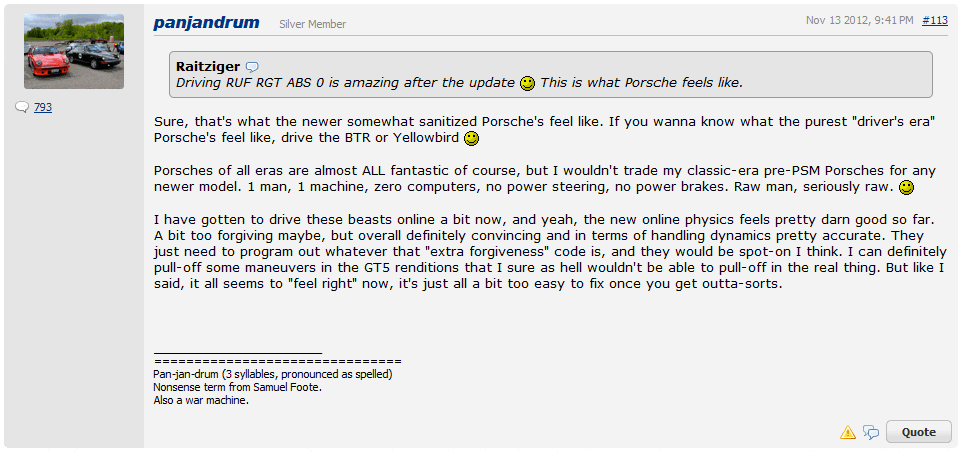GT5 has its flaws but yano what ? It works well with them.
On that point I can't agree at all, GT5's tyre model flaws are rather obvious and it certainly doesn't work well with them at all, I would go so far as to say that its starting to hold the series back as a whole. I for one will not be buying GT6 if they don't make a serious change in this area and I know for a fact I'm not the only one.
Would you rather have a highly complex model that didn't work in practice, or a simple one that works almost perfectly given the limited parameters being looked at?
Why should I be limited to those two choices (one of which is not even true - GT5's simple tyre model does not work almost perfectly)?
I would rather have a complex model that works and works well, its not that its impossible, it has after all been done by many other developers (and as I have shown as far back as the PS2)
What the rather amazing yet simple GT5 tire model gives us is epic room for improvement, all they have to do is keep the current model exactly as it is pretty much and add on some extra parameters (obviously not that simple).
Amazing is one of the last words I would use for GT5's tyre model, I would however agree that it has room for improvement, and a lot of it. However adding a few more parameters to the existing model is not going to lead to any significant changes and that you think it would makes me suspect that you don't really understand what is involved in creating a solid tyre model.
I've used PC sims that have worse models, that suffer from uncatchable drifts or weird levels of grip or sudden overseer over almost every curb (the list is huge). Yet in theory these models are amazing and so complex.
So because other people haven't got it right then its not worth trying?
What about all the sims (on any platform) that have done it better than PD, often with less resources?
You are once again attempting to say that the only two routes are a simple model that sort of works or a complex model that doesn't work, which is patently absurd.
It makes me really confident in GT6's tire model.
Your one of the few; given that they have put almost no work into it since GT4, I have very little confidence at all.
Flaws and all, GT5's tire model works really well when you consider what it has to work with (inputs and performance constraints).
Drifting isn't quite right but its very close !
Racing isn't quite right but its very close !
Mastering three things: grip, slip, and the transition between the two are the main points, most seem to just focus on grip while GT5 with its limited inputs does pretty dam well with all 3.
You can't fault it too much really.
I can fault it rather a lot and have done:
- Changes in tyre grade act as a grip multiplier nothing more
- Almost digital transition from grip to slip, indicates the use of basic 'magic' curves, with little or no cross referencing when load changes
- Tyre width isn't accounted for (as can be see with a Mini Cooper and a 'Vette having the same lat-g figure on the same compound)
- Tyre pressures are not modeled
- No options to change width, profile or pressure
- Tyre deformation is not modeled
For a model that does things well please explain why the RUF's don't act as a car of its design should (which should be chronic power-on understeer - not chronic power-on oversteer - tyre width issues) or a Mini Cooper can have the same lat-g as a 'vette on the same tyre compound (once again tyre width not being accounted for) or the lack of torque steer from a standing start (tyre deformation and static/low speed load distribution issues with the 'magic' model) or that changes in tyre compound simply increase the lat grip by a set amount (with the only variable per car being the starting point).
I for one don't class that as a tyre model that is doing things well, unless you want to use GT5 rather than reality as a benchmark.
I love the GT series with a passion (as my posting and testing history here will show), however with GT5 they have seriously dropped the ball and I don't for a second think that being apologetic for them is the answer.


